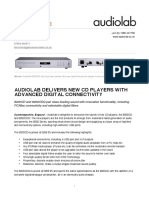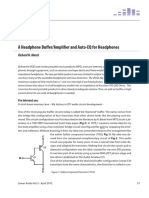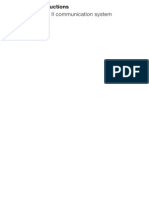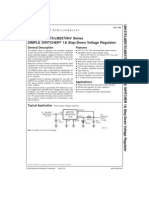Aqua La Voce s3 Dac - HFW - Aug18
Aqua La Voce s3 Dac - HFW - Aug18
Uploaded by
JohnCopyright:
Available Formats
Aqua La Voce s3 Dac - HFW - Aug18
Aqua La Voce s3 Dac - HFW - Aug18
Uploaded by
JohnOriginal Description:
Original Title
Copyright
Available Formats
Share this document
Did you find this document useful?
Is this content inappropriate?
Copyright:
Available Formats
Aqua La Voce s3 Dac - HFW - Aug18
Aqua La Voce s3 Dac - HFW - Aug18
Uploaded by
JohnCopyright:
Available Formats
REVIEW
HI-FI WORLD
Finding one’s Voce
Martin Pipe examines a very unusual
DAC from Italy.
W
hen designing a digital that boasts a range of interesting at least three other firms (MSB, Holo
audio product like a concepts – modular construction, Audio and Denafrips) making them.
streamer, CD player electromagnetic isolation of the Claimed reproductive advantages
or DAC it’s com- DAC circuitry with Optologic, the include a more immediate and open
mon to use bought- rejection of op-amps in the signal character.
in components to path, specially-developed timing La Voce, like its siblings, has
perform the critical function of chains and much more... that proprietary AQlink among its
converting digital data into analogue. La Voce, now into its ‘S3’ four inputs. The other three are
Companies like Burr-Brown/TI, incarnation, represents the most ‘modular’ (the review sample was
Cirrus, ESS, Analog Devices and cost-effective way of buying into fitted with an XLR for AES/EBU,
Wolfson specialise in designing chips this approach. Previous DAC boards although alternatives like optical can
for this task, pouring millions of dol- available for La Voce include DAC be specified), S/PDIF (BNC, rather
lars into their development. chips like the Burr-Brown PCM1704, than phono) and ‘bit-perfect’ USB for
But some companies prefer to Analog Devices AD1865 and even Class 2 computer audio. Analogue
design their own digital converters the Philips TDA1541A. But now the outputs are available in balanced XLR
in-house. In the UK, the best known La Voce has its own incarnation of and unbalanced phono form.
are Chord Electronics and dCS with an Aqua-developed multi-bit DAC True to Aqua’s word, the
their Ring DAC (they also came up that is fashioned from discrete analogue audio circuitry relies on
with DoP), whilst Prism Audio take components and underpins the firm’s transistors rather than op-amps for
a hybrid approach, hitching circuitry more exclusive La Scala (£5,990) and its capacitor-free signal path. Separate
to specific sections of a commercial Formula xHD (£11,990) converters. power supplies – each fed from a
DAC chip. It uses a technique, known as the dedicated toroidal mains transformer
And now, from Italy, we have ‘R-2R ladder’, that harks back to the – are provided for the analogue and
the mysterious Aqua (‘Acoustic very early days of digital-to-analogue digital sections. There’s no means
Quality’), who hail from Milan. conversion. At 16 or 24-bit resolution (front-panel LEDs, etc.) of confirming
Their £3,395 La Voce DAC I am it’s difficult to achieve required sample rate of the currently-selected
reviewing here. In appearance it's precision, meaning non-linearity – in source. La Voce is compatible with
very much the archetypical audiophile other words, distortion. In stereo, DSD64 and DSD128 (all inputs
product – substantial build quality, channels commonly differ for the support DoP), and PCM all the way
and an elegant aluminium frontage same reason. to 384kHz/24-bit. No MQA, though.
sporting the bare minimum of Modern delta-sigma DACs have
controls (power, input selection addressed the problem, but practical SOUND QUALITY
and digital-phase inversion). La Voce DACs built around discrete R-2R I used the Cambridge CXN V2
is the entry level model in a range ladders remain available – there are streamer I review elsewhere in this
HI-FI WORLD AUGUST 2018 www.hi-fiworld.co.uk
REVIEW
Orchestra/Evgeni Svetlanov, CD rip)
HI-FI WORLD
a satisfying degree of musical scale
and space. It tended towards the
bright; I suspect that’s more down
to a recording over half a century
in vintage, than a vintage DAC
philosophy successfully brought up to
date.
CONCLUSION
Congratulations to Aqua for daring
to be different – and succeeding.
Although this unusual DAC design
doesn’t measure particularly well,
it’s an engaging listen from the
At bottom-right is the R-2R DAC board - count those resistors! outset – the claimed advantage of
Underneath it is a powerful DSD chip that does decoding and 'old-fashioned' ladder DACs. I was
conversion of serial data into the parallel form needed by the impressed and feel it is well worth
DAC section. auditioning.
Also, modular design ensures
issue (connected to La Voce via Cracked (Sleep Games, CD rip) that La Voce should be able to
coaxial digital) and a USB-interfaced and Mogwai’s Remurdered (Rave accommodate DAC fashions and
Windows 7 PC as sources. You have Tapes, 24-bit) were all resolved technological changes in music-
to download the Windows drivers, distinctively; the latter track’s drums delivery technology, for as long as
which also include a control panel and cymbal-crashes sounded clean, Aqua decides to support it.
program, from the Aqua website. with no sound of
Regrettably, there’s nothing in the overload. Orchestral
rather-inadequate manual to explain work also fares
how to set up playback software well, La Voce
like Foobar2000 (free) and JRiver managing to tease
Media Center (commercial) for use out of an archive
with the La Voce. I couldn’t find any (1967) Soviet-era
information on the firm’s website, performance of La Voce has four inputs, the AQLink being for their own trans-
either. Tchaikovsky's port. An optical connector would find more favour! In our review
Output was fed to an Arcam Fourth Symphony sample, the modular input is AES/EBU – you also get S/PDIF and
A49 integrated amplifier, driving (USSR Symphony asynchronous USB.
a pair of Quadral Aurum Wotan
VIII floorstanders – I also used
headphones.
MEASURED PERFORMANCE
Via its BNC socket S/PDIF digital input outputs (-60dB, 24bit) – around 10x
Test results for La Voce are
the La Voce produced 0.28% / 0.15% more than common and unbalanced
not inspiring, but in my view it’s
distortion from Left / Right channel between channels, via both XLR and
worth moving to a DAC that
Phono socket outputs. Input via AES/EBU
measures relatively-poorly if there’s a
FREQUENCY RESPONSE offered no improvement.
perceptible sonic advantage.
Dynamic range (EIAJ) was as a
And La Voce definitely delivers
that! One thing this converter has
result low, measuring at 104dB (Left) AQUA LA VOCE S3
above all else is energy, as tracks like
and 107dB (Right), little better than CD £3,395
(103dB) and well below the 115dB or so
David Bowie’s ‘Tis a Pity She Was a
common nowadays for hi-res, let alone
Whore (24-bit) amply demonstrate. EXCELLENT - extremely
117dB-123dB of top DACs.
Excitement abounds; in comparison, capable
Frequency response measured flat
the admittedly much-cheaper
to 51kHz (192kHz sample rate); there is
Cambridge player (attached to VERDICT
no optical input so frequency response Good sound, different from
another of the Arcam’s numerous line
wasn’t an issue. the norm.
inputs) sounds rather restrained and DISTORTION Output measured 5.5V from the XLR
polite. The more reflective track that FOR
(balanced) socket outputs and 2.6V from
follows it on Blackstar, Lazarus, also - energetic and musical sound
the phono socket (unbalanced) outputs.
engages the senses while acting as a - a beautifully-made modular
The Aqua measured poorly by design
showcase for La Voce’s other talents.
current standards, exhibiting high
Its presentation here is very detailed,
distortion and low dynamic range. NK AGAINST
and it’s easy to follow the sax line - no visual confirmation of
while the percussion thrashes away in Frequency response (-1dB) input signal type
the background. - no filter options
8Hz-51kHz
The individual atmospheres - documentation needs
Distortion (-60dB, 24bit) 0.28% improvement
and lush synthetic tones of Boards Separation (1kHz) 95dB
of Canada’s Reach for the Dead Noise (IEC A) -104dB Elite Audio
(Tomorrow’s Harvest, CD rip), Pye Dynamic range (EIAJ) 106dB +44 (0)1334 570 66
Corner Audio’s The Mirror Ball Output (XLR/Phono) 5.5V / 2.6V www.eliteaudiouk.com
www.hi-fiworld.co.uk AUGUST 2018 HI-FI WORLD
You might also like
- Building and Operating The Digital Sony SRF-39Document4 pagesBuilding and Operating The Digital Sony SRF-39englagra0% (1)
- HiFi Stereo Review 1984 Tape Recording GuideDocument136 pagesHiFi Stereo Review 1984 Tape Recording Guidejdap2000-1100% (1)
- APL DSD SR2 HiFiPlusDocument3 pagesAPL DSD SR2 HiFiPlusjovan jelicNo ratings yet
- Micromega Mydac Usb Dac: Equipment ReportDocument2 pagesMicromega Mydac Usb Dac: Equipment ReportMiguel Ángel Muñoz MarquésNo ratings yet
- DCS Vivaldi DAC v2 0 DatasheetDocument2 pagesDCS Vivaldi DAC v2 0 DatasheetHéritier NealNo ratings yet
- HFN 0819 ARC CD9SE ReprintDocument2 pagesHFN 0819 ARC CD9SE Reprintjohn299No ratings yet
- Vivaldi SUper Hi-Fi SystemDocument10 pagesVivaldi SUper Hi-Fi SystemJulio CardenasNo ratings yet
- Buffalo DACDocument23 pagesBuffalo DACandree w100% (2)
- Accuphase Fiche DP510Document4 pagesAccuphase Fiche DP510zebNo ratings yet
- Digital-To-Analog Converter - Wikipedia, The Free EncyclopediaDocument8 pagesDigital-To-Analog Converter - Wikipedia, The Free EncyclopediaAnilkumar KubasadNo ratings yet
- Black Dragon Hifi News 1Document3 pagesBlack Dragon Hifi News 1Božidar ŽuricNo ratings yet
- 8-Channel Dac With PLL and Differential Outputs, 192 KHZ, 24 BitsDocument28 pages8-Channel Dac With PLL and Differential Outputs, 192 KHZ, 24 BitsIvan AlyaevNo ratings yet
- Behind The Bucket BrigadeDocument23 pagesBehind The Bucket Brigadefusgtr100% (4)
- SL PS840 - Hi Fi News 1994 04 IDX 41Document1 pageSL PS840 - Hi Fi News 1994 04 IDX 41Meta TronixNo ratings yet
- Helen EdacDocument12 pagesHelen Edacslobodan.jovanovic.jaNo ratings yet
- DCD 1510aeDocument2 pagesDCD 1510aeBijan KarimkhaniNo ratings yet
- AudioLab Press 280Document5 pagesAudioLab Press 280Nikos PsarasNo ratings yet
- Ukdvdavca1xv PDFDocument20 pagesUkdvdavca1xv PDFHELLOGREGNo ratings yet
- DSD DatabaseDocument9 pagesDSD DatabaseJon LesterNo ratings yet
- All About Amps Vol 18Document22 pagesAll About Amps Vol 18Ale BouwmanNo ratings yet
- Premium Super Audio CD Player: WWW - Marantz.euDocument2 pagesPremium Super Audio CD Player: WWW - Marantz.eugbeszeNo ratings yet
- Sony Super Audio CD (SACD) Promo BrochureDocument8 pagesSony Super Audio CD (SACD) Promo BrochurealancatsNo ratings yet
- Audiophilia September 2008Document4 pagesAudiophilia September 2008Dave Adams100% (1)
- Effects in High Sample Rate Audio MaterialDocument4 pagesEffects in High Sample Rate Audio MaterialtagezNo ratings yet
- Audio Technology: Audio Technology / A/D Conversion and Digital Audio Signal Transfer..Document3 pagesAudio Technology: Audio Technology / A/D Conversion and Digital Audio Signal Transfer..dice midyantiNo ratings yet
- Bel Canto DAC2Document7 pagesBel Canto DAC2philaskNo ratings yet
- Nov20 DigitalPress AllAboutAmpsReviewEditionVol2Document28 pagesNov20 DigitalPress AllAboutAmpsReviewEditionVol2Daniel EscobarNo ratings yet
- Soundcraft Notepad-12FX Sell Sheet 2 PagesDocument2 pagesSoundcraft Notepad-12FX Sell Sheet 2 PagesAlan Luigi Ladrera FloresNo ratings yet
- 4 Adc/8 Dac With PLL, 192 KHZ, 24-Bit Codec Ad1939: Features General DescriptionDocument32 pages4 Adc/8 Dac With PLL, 192 KHZ, 24-Bit Codec Ad1939: Features General Descriptionsuan kwang TanNo ratings yet
- Hi-Fiworld Review of C 325BEEDocument2 pagesHi-Fiworld Review of C 325BEEmancic55No ratings yet
- ZR38650Document66 pagesZR38650BaCresNo ratings yet
- Network CD Receiver: Feel It in High ResolutionDocument2 pagesNetwork CD Receiver: Feel It in High ResolutionDDroNo ratings yet
- Ad1939 PDFDocument32 pagesAd1939 PDFMax MaierNo ratings yet
- Rotel RA-1592: Integrated AmplifierDocument3 pagesRotel RA-1592: Integrated AmplifierMinh TiếnNo ratings yet
- Better Than Hi-Res!: MQA Revolutionizes Digital AudioDocument22 pagesBetter Than Hi-Res!: MQA Revolutionizes Digital AudiohisohisoNo ratings yet
- A Headphone Buffer/Amplifier and Auto-EQ For Headphones: Richard N. MarshDocument14 pagesA Headphone Buffer/Amplifier and Auto-EQ For Headphones: Richard N. Marshozzy123No ratings yet
- Tas 194 Meridian 7200Document14 pagesTas 194 Meridian 7200nikospapaioannouNo ratings yet
- PB cx20562Document2 pagesPB cx20562levitrimNo ratings yet
- Sacd 1250 R enDocument4 pagesSacd 1250 R enLEVENT TOSUNNo ratings yet
- DAC Final TestDocument21 pagesDAC Final TestKemboya LuigiNo ratings yet
- Poptronics 1975 09Document100 pagesPoptronics 1975 09shirtquittersNo ratings yet
- dENON A11Document2 pagesdENON A11energiculNo ratings yet
- Erno Borbely Servo 100 From Audio-Amateur-1984-1Document64 pagesErno Borbely Servo 100 From Audio-Amateur-1984-1ehsannemesis6No ratings yet
- Duncan VCAs Part 1Document5 pagesDuncan VCAs Part 1Ian PressNo ratings yet
- ANT Kora LTD 2Document2 pagesANT Kora LTD 2bob623fNo ratings yet
- Marantz DAC White Paper 4 5 2016 PDFDocument16 pagesMarantz DAC White Paper 4 5 2016 PDFleofmartinsNo ratings yet
- S/PDIF Output: For OSCAR and Other Digital Audio-EquipmentDocument4 pagesS/PDIF Output: For OSCAR and Other Digital Audio-Equipmentlaszlo1231No ratings yet
- Onkyo User ManualDocument3 pagesOnkyo User ManualDDroNo ratings yet
- D 1050 Usb Dac: Totally ConnectedDocument2 pagesD 1050 Usb Dac: Totally Connectedcosmin_xfNo ratings yet
- TAS-Focal Chora 826 ReviewDocument4 pagesTAS-Focal Chora 826 ReviewDebjit GhoshNo ratings yet
- Audiolab CD8000 CD Player ReviewDocument4 pagesAudiolab CD8000 CD Player ReviewJohnny Khong0% (2)
- Lect1 PDFDocument19 pagesLect1 PDFAhmed ELNaggarNo ratings yet
- Focusrite LIQUID Saffire 56 ReviewDocument24 pagesFocusrite LIQUID Saffire 56 ReviewKalygulyNo ratings yet
- Digital Recording History NOTES (Music Technology Edexcel)Document2 pagesDigital Recording History NOTES (Music Technology Edexcel)Alex HynesNo ratings yet
- DA100 Manual Eng-1Document14 pagesDA100 Manual Eng-1Dimitris ZampelisNo ratings yet
- 16-Channel High Performance Differential Output, 192 KHZ, 24-Bit DacDocument52 pages16-Channel High Performance Differential Output, 192 KHZ, 24-Bit DaczorkerNo ratings yet
- Cae Mc404 ManualDocument1 pageCae Mc404 ManualdemonclaenerNo ratings yet
- User Guide - Audix DP7Document2 pagesUser Guide - Audix DP7jeremy.sNo ratings yet
- Active-Filtering Circuit For Audio Dacs: Analog Engineer'S Circuit: Data ConvertersDocument6 pagesActive-Filtering Circuit For Audio Dacs: Analog Engineer'S Circuit: Data Convertersraffy mundungNo ratings yet
- 5 Compact Track PlansDocument12 pages5 Compact Track PlansKilty ONeal100% (3)
- Operating Instructions BMW v.O.I.C.E. II Communication System For K1200 LTDocument32 pagesOperating Instructions BMW v.O.I.C.E. II Communication System For K1200 LTcluainsiNo ratings yet
- UNICEF Nigeria Cholera Situation Report - 10 February 2014Document4 pagesUNICEF Nigeria Cholera Situation Report - 10 February 2014Jasmine DaisyNo ratings yet
- Preposotion NotesDocument19 pagesPreposotion NotesABHISHEK MISHRANo ratings yet
- 1933 Process For Manufacturing Barium Sulphate of Definite Granule SizeDocument2 pages1933 Process For Manufacturing Barium Sulphate of Definite Granule SizeDeluxe pNo ratings yet
- A Very Subtle ExerciseDocument4 pagesA Very Subtle ExerciseNicole HawkinsNo ratings yet
- Air Consumption CalculationDocument8 pagesAir Consumption CalculationocchityaNo ratings yet
- Vehicle History: Registration Number: DL12CQ9217 No - of Visits Requested:11Document10 pagesVehicle History: Registration Number: DL12CQ9217 No - of Visits Requested:11kamran.shahNo ratings yet
- Talking It OverDocument4 pagesTalking It OverVirginia AlvarezNo ratings yet
- Level 9 Grammar Practice BookDocument10 pagesLevel 9 Grammar Practice BookNicolasNo ratings yet
- Jodel D120A Maintenance ScheduleDocument4 pagesJodel D120A Maintenance ScheduleMark JuhrigNo ratings yet
- Energy IoT Platform BrochureDocument8 pagesEnergy IoT Platform BrochureDante RendaNo ratings yet
- Sexually Transmitted Infections Basics in DiagnosisDocument95 pagesSexually Transmitted Infections Basics in Diagnosistummalapalli venkateswara raoNo ratings yet
- Philippine Official Reference For Forest-Related Terms and DefinitionsDocument54 pagesPhilippine Official Reference For Forest-Related Terms and DefinitionsJoseph VillafuerteNo ratings yet
- Report Text: By: Vandrektus Derek, A.MdDocument15 pagesReport Text: By: Vandrektus Derek, A.MdfakhruroziNo ratings yet
- Cahpter#3-PPT-Chang 14e PPT Module03Document101 pagesCahpter#3-PPT-Chang 14e PPT Module03Maryam Al-AthbaNo ratings yet
- B V DoshiDocument8 pagesB V DoshiImaad UddinNo ratings yet
- Rationalism Romanticism Transcendentalism 2012Document21 pagesRationalism Romanticism Transcendentalism 2012Ms. Katie PetersonNo ratings yet
- Cribl What Is ObservabilityDocument6 pagesCribl What Is ObservabilityPast homeNo ratings yet
- Method of Statement For Hydrant Pipe Joining Revised (Collar Joint)Document5 pagesMethod of Statement For Hydrant Pipe Joining Revised (Collar Joint)Ben LimNo ratings yet
- Flexco Belt CleanersDocument46 pagesFlexco Belt Cleanersrofano aswanNo ratings yet
- 7 - Forced Paraxial Wave Equation and Gaussian Beams: EE 346 Nonlinear Optics M.M. Fejer 01/27/21Document18 pages7 - Forced Paraxial Wave Equation and Gaussian Beams: EE 346 Nonlinear Optics M.M. Fejer 01/27/21bobbyy222No ratings yet
- Grade 5 Unit 1 - 2 Parent GuideDocument3 pagesGrade 5 Unit 1 - 2 Parent GuideKathlyn VerdaderoNo ratings yet
- Spider SilkDocument22 pagesSpider Silkbl.en.u4eac23006No ratings yet
- Pesona Optometry2Document12 pagesPesona Optometry2Muhammad Irfan Naufal RamlanNo ratings yet
- De Vries - Archibald - 2018 - Plant Evolution - Landmarks On The Path To Terrestrial LifeDocument7 pagesDe Vries - Archibald - 2018 - Plant Evolution - Landmarks On The Path To Terrestrial LifeFernando AndradeNo ratings yet
- Indian Minerals Yearbook 2018: 57 EditionDocument4 pagesIndian Minerals Yearbook 2018: 57 EditionVirendra PratapNo ratings yet
- Quick Revision Notes - 2 - Electrostatic Potential and CapacitanceDocument11 pagesQuick Revision Notes - 2 - Electrostatic Potential and CapacitanceManish KedawatNo ratings yet
- LM1575/LM2575/LM2575HV Series SIMPLE SWITCHER® 1A Step-Down Voltage RegulatorDocument25 pagesLM1575/LM2575/LM2575HV Series SIMPLE SWITCHER® 1A Step-Down Voltage RegulatorSherif EltoukhiNo ratings yet
- Digital Signal Processing by C Ramesh Babu Durai PDFDocument303 pagesDigital Signal Processing by C Ramesh Babu Durai PDFvanithapremkumar0% (1)

























































































